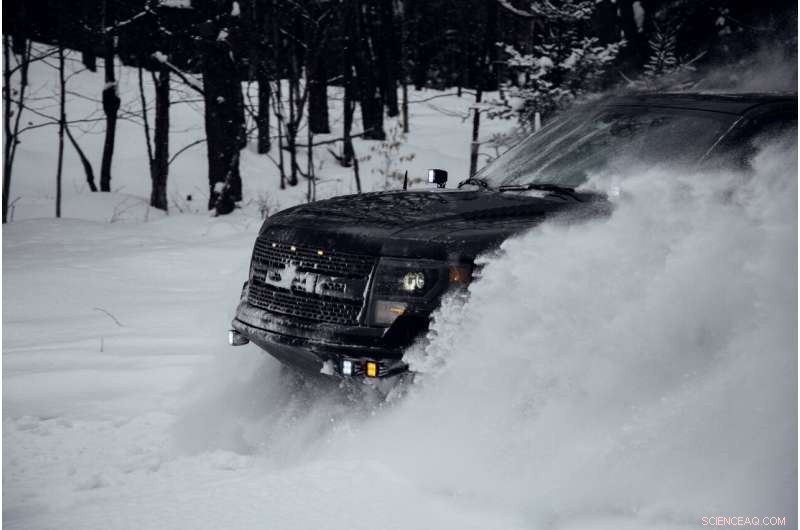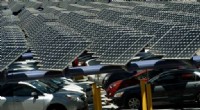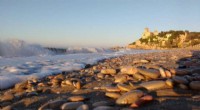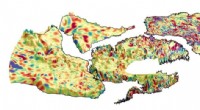
Wetenschap
Michigan winters, zoals generaties ze hebben gekend, komt misschien een einde

Tegoed:Unsplash/CC0 Publiek domein
Karl Schwartz wenste dat hij gewoon de roem najaagde op de sneeuwscooterracebaan. In plaats daarvan, in recente jaren, hij is gedwongen om steeds ongrijpbaarder koud weer te achtervolgen.
Schwartz, van Vrijland, is voorzitter van de Midwest International Racing Association, een racecircuit voor sneeuwscooters dat al meer dan 40 jaar voornamelijk in Michigan actief is. Hun weekendraces trekken ongeveer 100 teams, honderden racers en bemanningsleden, en duizenden meer fans, meestal als onderdeel van het winterfestival van een lokale gemeenschap.
Maar elk jaar, als het klimaat in Michigan verandert, het wordt steeds moeilijker om te doen.
"We racen op ijs, geen sneeuw, ' zei hij. 'We hebben geen sneeuw nodig - we hebben koude temperaturen nodig.'
De racers strijden vaak op kermispaardenbanen, overspoeld met honderdduizenden gallons water om te proberen een basis van bevroren grond te bouwen die de racers zullen opeten tijdens een competitieweekend. Ze hebben in de tienerjaren ongeveer twee weken temperatuur nodig om de juiste omstandigheden te creëren. Met toenemende frequentie, dat wordt bijna onmogelijk te vinden, aldus Schwartz.
"Ondanks onze inspanningen om onze kalender te verplaatsen, en deze racebanen weken van tevoren water geven, we moeten nog steeds datums verplaatsen, annuleer data en race in minder dan perfecte omstandigheden vanwege het warme weer, " hij zei.
"Dit is een constant probleem voor ons geweest, vooral de afgelopen jaren. Het duurt al langer, maar vooral de afgelopen vijf jaar, het is echt geweest, echt problematisch."
Het bestuur van de racevereniging heeft de afgelopen jaren vergaderd om te bespreken wat het kan, inclusief het verplaatsen van meer races verder naar het noorden.
"(Maar) we zijn al in Sault Ste. Marie, " in het oostelijke Upper Peninsula aan de Canadese grens, aldus Schwartz. "Twee races daar, en ze kunnen het niet eens koud genoeg krijgen. Onze race in Ironwood (in het uiterste westen van de U.P.) had problemen, te.
"Als je geen ijs kunt krijgen aan de Canadese grens, hoeveel verder naar het noorden kun je gaan?"
Michigan is koud, besneeuwde winters, en een manier van leven om hen heen gebouwd, worden verstoord door klimaatverandering. En voor winterfestivals die afhankelijk zijn van kou, sneeuw en ijs - en gemeenschappen die afhankelijk zijn van de economische impuls in een langzame tijd die die festivals brengen - veroorzaakt wat klauteren om zich aan te passen, en zelfs om te overleven.
Het gebied van de Grote Meren heeft een grotere stijging van de jaarlijkse gemiddelde temperaturen gezien dan de rest van de continentale VS en "de winters worden sneller warmer dan de zomers, " zei Richard Rood, een professor in klimaat- en ruimtewetenschappen en techniek aan de Universiteit van Michigan.
"De planeet warmt in het algemeen op, maar staten als Wisconsin, Michigan en Illinois worden warmer, sneller, " zei Don Wuebbles, een professor in de afdeling Atmosferische Wetenschappen aan de Universiteit van Illinois.
De sneeuwval in het stroomgebied van de Grote Meren is tussen 1984 en 2013 met 2,25% gedaald, vergeleken met 1954 tot 1983. Onderzoekers voorspellen dat de sneeuwval tegen 2080 met bijna 48% zou kunnen afnemen in een business-as-usual-scenario zonder verminderde menselijke koolstofemissies. Maar zelfs in een optimistischer scenario, waar de uitstoot van broeikasgassen aanzienlijk wordt beperkt, De verwachting is dat de wintersneeuwval in het stroomgebied van de Grote Meren tegen 2080 met meer dan 28% zal afnemen.
Het aantal dagen dat de lage temperatuur onder het vriespunt zakt, 32 graden Fahrenheit, in het gebied van de Grote Meren zal volgens de prognoses van wetenschappers met meer dan een maand per jaar afnemen in het scenario met hogere emissies, en met drie weken in het scenario met lagere emissies. En dagen waarop de hoge temperatuur onder het vriespunt blijft - het soort constant koude winterdagen die nodig zijn voor activiteiten zoals sneeuwscooteren, ijsvissen, langlaufen en meer - zullen naar verwachting met 56 dagen per jaar afnemen als gevolg van hogere koolstofemissies, en met 31 dagen onder een lagere uitstoot.
Michigan winters, zoals generaties ze hebben gekend en erop vertrouwden, einde lijkt te komen. Koude buien en zware sneeuw met meereffect zullen nog steeds voorkomen, maar gebeuren in steeds minder frequente uitbarstingen in de loop van de tijd.
"Terwijl het in bepaalde regio's nog steeds veel sneeuwt, hoe het zich gedraagt als het eenmaal op de grond is, verschilt nogal, ' zei Rood. 'Het duurt niet zo lang, en het wordt slordig als er regen op valt.
"Het hoeft niet zo veel warmer te zijn dat je meer-effect regen krijgt in plaats van meer-effect sneeuw."
Tegen het einde van de eeuw, in een scenario van aanhoudend hoge koolstofemissies, wetenschappers voorspellen dat de jaarlijkse gemiddelde temperatuur in Michigan met 9 of 10 graden Fahrenheit zou kunnen stijgen, zei Wuebbles.
"Dat is veel, heel ander klimaat, "zei hij. "Ter vergelijking, de laatste ijstijd, die ijs 2 mijl dik hier bracht, de temperatuur was 11 graden koeler dan vandaag."
Winter Fest is afgelast - alweer
De winterfestivals van Michigan staan dit jaar voor een andere uitdaging:de COVID-19-pandemie. Maar de afgelopen jaren is verstoring is het gevolg van een gebrek aan traditionele winterse omstandigheden.
Het Caro Winterfeest, in de Thumb-regio van het Lower Peninsula van Michigan, evenementen geannuleerd voor de tweede winter op rij in januari. Het festival is opgebouwd rond de sneeuwscooterraces van de Midwest International Racing Association.
"De afgelopen jaren the temperatures have not cooperated whatsoever before the event, " said Kris Reinelt, Caro Winter Fest board president.
Festival staff usually begin flooding the Tuscola County Fairgrounds to build ice layers for the snowmobile racing track after the holidays, in preparation for the Winter Fest races, usually held around the third weekend of January.
"We need at least a week of consistent, low temperatures, " Reinelt said. "We would be able to build up 1 or 2 inches of ice a night, but then in the daytime, it would warm up and take it away.
"We have to pay for the water, we have to pay for the time. It doesn't become cost-effective to fight that battle."
The lost festivals over back-to-back years, and threatened again in 2021 by the coronavirus, cause a painful economic hit for the community.
"The racing teams bring in 300 people just among the racers, their families and friends who follow them, " Reinelt said. "In Caro, we draw another 3, 000 mensen. Those are 3, 300 people who may never come to Caro, and they are coming in the middle of winter, which is a slow time. That's so helpful to the hotels, restaurants, grocery stores."
At Tip-Up Town U.S., Michigan's longest-running winter festival, established in 1953 and built around ice fishing on Houghton Lake, nearly a dozen people fell through the ice last January, their snowmobiles, four-wheelers and other vehicles breaking through thin ice that was open water less than a week earlier.
The Kalkaska Winterfest, in northern Lower Michigan, features one of the Midwest's largest dog-sledding sprint races, going back to 1965—longer-running than the famed Iditarod in Alaska.
in 2017, the races scheduled for January were postponed until the first week of March because of a lack of wintry conditions. When it was more of the same in March, the races were canceled.
in 2018, the races were postponed in January, then canceled in February. Het volgende jaar, the January dates were again moved to February, when the latter half of the racing schedule that weekend was canceled because "everything had just melted, " said Shannon Moore, a race marshal and board secretary for the Winterfest.
"That was something I'd never seen at a dog race, ever, " ze zei.
At the local hotel sponsoring the event and hosting race teams and their families, the All Season Resort, "they go from being completely booked to 5% occupancy when we cancel, ' zei Moor.
Many of the dog-sledding teams come from out of state, as much as 10 hours away, and bring kennels and trucks, crews and families. Though 2020's races went off without a hitch in mid-February, the more races that get postponed, canceled or happen in poor conditions, the more worry that teams won't bother coming, zei Moor.
"I think we'll have to keep aiming for February and hoping we get lucky, " she said. "When we do it later in March, that's not going to work. And the January dates haven't been working, of."
Snowmobile sales plummet 70%
Carl Gerstacker was a snowmobiling fanatic.
"From the mid-'90s until about '05-'06, there was a solid 10 years where we put on just a ton of miles and had fun with it, " hij zei.
But the pastime got more expensive. And the right conditions became harder to find.
"The winters are hit-or-miss now, " he said. "We've had some really good winters, where the guys are up there (in northern Michigan) feasting on perfect conditions. But when you're making payments on a $15, 000 machine, you need some consistency."
Gerstacker and his friends were "weekend warriors"—"get off work a little early on Friday, head north, spend the weekend riding the trails, head back home Sunday and go to work on Monday." But needing to go ever farther north to find the best, most consistent riding became a time-consuming, costly effort.
"If you're chasing snow into the U.P., that's not an option anymore, " the Brighton-area resident said. "You're talking eight to 10 hours of driving to get up into the good snow and the best trails."
Gerstacker in recent years has changed out the sleds for a side-by-side, a four-wheeled recreational vehicle featuring two rows of seating that his wife and two children can enjoy with him.
"There's always dirt, there's not always snow, " he said. "I'm watching my buddies making payments on these (snowmobiles), and they are going to ride two months this year. And these quick little shots Up North are expensive, te.
"I don't look back. I enjoy the side-by-side more than I ever did snowmobiling."
Gerstacker isn't alone in leaving snowmobiles behind. Snowmobile sales in the U.S. are down 70% from their 1997 peak, according to the International Snowmobile Manufacturers Association, a Haslett-based trade organization representing North America's four major snowmobile manufacturers:Arctic Cat; Ski-Doo/Bombardier; Polaris and Yamaha.
The Michigan Snowmobile Association, a Wyoming, Michigan-based nonprofit organization promoting and preserving the sport, also saw the changing reality. In mei 2019, its board—over the protests of some sledding die-hards—voted to become the Michigan Snowmobile and ORV Association, adding off-road vehicles under its canopy.
"They are motorized, we are motorized, and very often we have the same goals and objectives, " such as promoting trail access, said Karen Middendorp, the association's executive director.
Changing weather is unquestionably a factor in snowmobiling's decline, ze zei.
"You can't ride every weekend, especially for the down-staters, " she said. "There's not enough snow."
Snowmobiling exploded in popularity in the mid-1990s to mid-2000s, bringing $321 million in sales, $187 million in income, and more than 6, 000 jobs to Michigan's economy, according to a 1998 Michigan State University study. It was primarily driven by baby boomers who had reached a more comfortable point in their lives and had the disposable income to afford, and the time to enjoy, snowmobiling. But now that population cohort is waning in the sport, said Edward Klim, executive director of the snowmobile manufacturers association.
"We have started to really look at millennials and Generation X. Are they recreating in the snow? Are they riding snowmobiles?" hij zei. "How does the next generation want to recreate? Some people will buy an ATV or UTV (utility terrain vehicle) and use it nine or 10 months a year."
It's a reality snowmobile dealers have been forced to confront:change or die.
"The writing was on the wall 10-plus years ago, " said Mike Nord, owner of Nord-Ride Motorsports in Mount Morris Township.
Around 2000, there were as many as 10 snowmobile dealerships in the greater Genesee County area. Nord's is now the only one left.
"There are two negative things against it:The cost of it now, en het weer, " he said. "The dealers had to look at it and say, 'This isn't a good business decision any longer.'"
Nord has survived by diversifying his vehicles, adding ATVs, side-by-sides and more. But even that comes with risks.
"If you look at some of the dealers that have fallen by the wayside, they fell into this trap, " he said. "You have to be able to accommodate (these diverse recreational vehicles), so you have to get bigger on your buildings, and that means bigger on your overheads. You finance that to increase the size of your building, and all of a sudden, we have an economic downturn. There is no Plan B."
In tegenstelling tot, ski resorts have stayed relatively unscathed by warming weather because of their ability to make snow, said Amy Reents, executive director of the Midwest Ski Areas Association based in Hastings, Minnesota, a nonprofit trade group promoting skiing and ski resort interests in Michigan and surrounding states.
"We're not growing by leaps and bounds, but there haven't been any great fall-offs, " ze zei.
During a few days of cold weather, a ski resort can lay down several feet of manufactured snow, ze zei. It's then packed and groomed and provides a base with its own refrigeration.
"They can withstand several days in the 40s—it will do much better than the snow in your front yard, " Reents said.
"The changes in snow-making technology over the years have made it so much easier to make snow in warmer temperatures. If anything has changed for the ski industry, it's that (resorts) have decided that capital investing in snow-making technology is hugely important."
Adaptation is essential
Adaptation and diversification will become increasingly essential for Michigan's winter festivals to continue and thrive. Many have already figured that out.
From long-ago years where many of Tip-Up Town U.S.'s events were held on the thick ice of Houghton Lake, the festival now largely operates under large tents on the shore, featuring family fun, voedsel, music and merchants, said Jay Jacobs, executive director of the Houghton Lake Chamber of Commerce and a lead organizer of the festival.
Tip-Up Town typically draws about 10, 000 visitors over its two weekends of events at the end of January.
"It's very essential to us, " he said. "We rely on tourism—we don't have an industrial park; Houghton Lake doesn't have a defined downtown, een ziekenhuis, a university. These two weekends in the winter are a nice little shot in the arm for the community."
But even with diverse events not reliant on snow, ice or cold, a psychological deterrent can keep potential festival-goers home when it's warm out.
"It does affect the number of people who show up, " said Jacobs. "We've had a few years where it's been rainy, and people just don't hang around."
The Caro Winter Fest is so intricately tied to snowmobile races, it can't happen without them right now, Reinelt said. She wants to ask residents how they feel about changing that, in the wake of the recent, weather-related cancelations.
"I want to do polls on our Facebook:Would you come out in the middle of winter to watch a chainsaw ice competition, a warming tent with live entertainment, and a beer and wine bar?" she said.
A larger adaptation is needed, Rood said:a reduction in human-caused carbon emissions that are fueling climate change.
"These big changes should be major motivators to take on that carbon dioxide reduction problem, " hij zei.
©2021 the Detroit Free Press
Gedistribueerd door Tribune Content Agency, LLC.
Hoofdlijnen
- Wat is cyberchondrie?
- Wat betekent homozygoot?
- Wat zijn de vier stikstofbasen van DNA?
- Door klimaat beïnvloede veranderingen in bloei, vruchtvorming heeft ook invloed op de vogelstand, activiteiten
- Naarmate het klimaat warmer wordt, muizen morph
- Maak een lijst van de soorten informatie die gevonden kan worden door de sequentie van een DNA-molecuul te kennen Molecule
- Wat zijn Agar Slants?
- Onderzoekers ontdekken dat het nauwkeurig transcriberen van DNA het herstel van DNA opheft
- De effecten van ultraviolette straling op gist
- Verschil tussen mannelijke en vrouwelijke wolfspinnen

- Californië complotteert om AWOL Trump te bestrijden over klimaat

- Aan de kust van Tarragona, 57% van het plastic afval bestaat uit kledingvezels van wasmachines

- Los Angeles test verkoelende bestratingsverf om hitte te verslaan

- Magnetische link van Antarctica naar oude buren

 Wat zijn 3 overeenkomsten tussen magneten en elektriciteit?
Wat zijn 3 overeenkomsten tussen magneten en elektriciteit?  Kinderen houden niet van bloemkool, broccoli kan in hun microbioom worden geschreven
Kinderen houden niet van bloemkool, broccoli kan in hun microbioom worden geschreven Een schoolsysteem dat is afgestemd op individuele mogelijkheden in plaats van leeftijd klinkt goed, maar er is geen bewijs dat het werkt
Een schoolsysteem dat is afgestemd op individuele mogelijkheden in plaats van leeftijd klinkt goed, maar er is geen bewijs dat het werkt Bedrijven moeten investeren in menselijk kapitaal om concurrerend te blijven in een dynamische omgeving
Bedrijven moeten investeren in menselijk kapitaal om concurrerend te blijven in een dynamische omgeving NASA vindt zware regenval in tropische storm Dorian
NASA vindt zware regenval in tropische storm Dorian Onderzoekers stellen oplossingen voor netwerkvertraging in enorme IoT-apparaten voor
Onderzoekers stellen oplossingen voor netwerkvertraging in enorme IoT-apparaten voor Wetenschappers ontwikkelen sondes die zijn ontworpen om de fysieke krachten in levende cellen te onthullen; een wereldprimeur
Wetenschappers ontwikkelen sondes die zijn ontworpen om de fysieke krachten in levende cellen te onthullen; een wereldprimeur Opwarming van het klimaat zou de bacteriële impact op Chesapeake Bay-schelpdieren kunnen vergroten, recreatie
Opwarming van het klimaat zou de bacteriële impact op Chesapeake Bay-schelpdieren kunnen vergroten, recreatie
- Elektronica
- Biologie
- Zonsverduistering
- Wiskunde
- French | Italian | Spanish | Portuguese | Swedish | German | Dutch | Danish | Norway |

-
Wetenschap © https://nl.scienceaq.com


